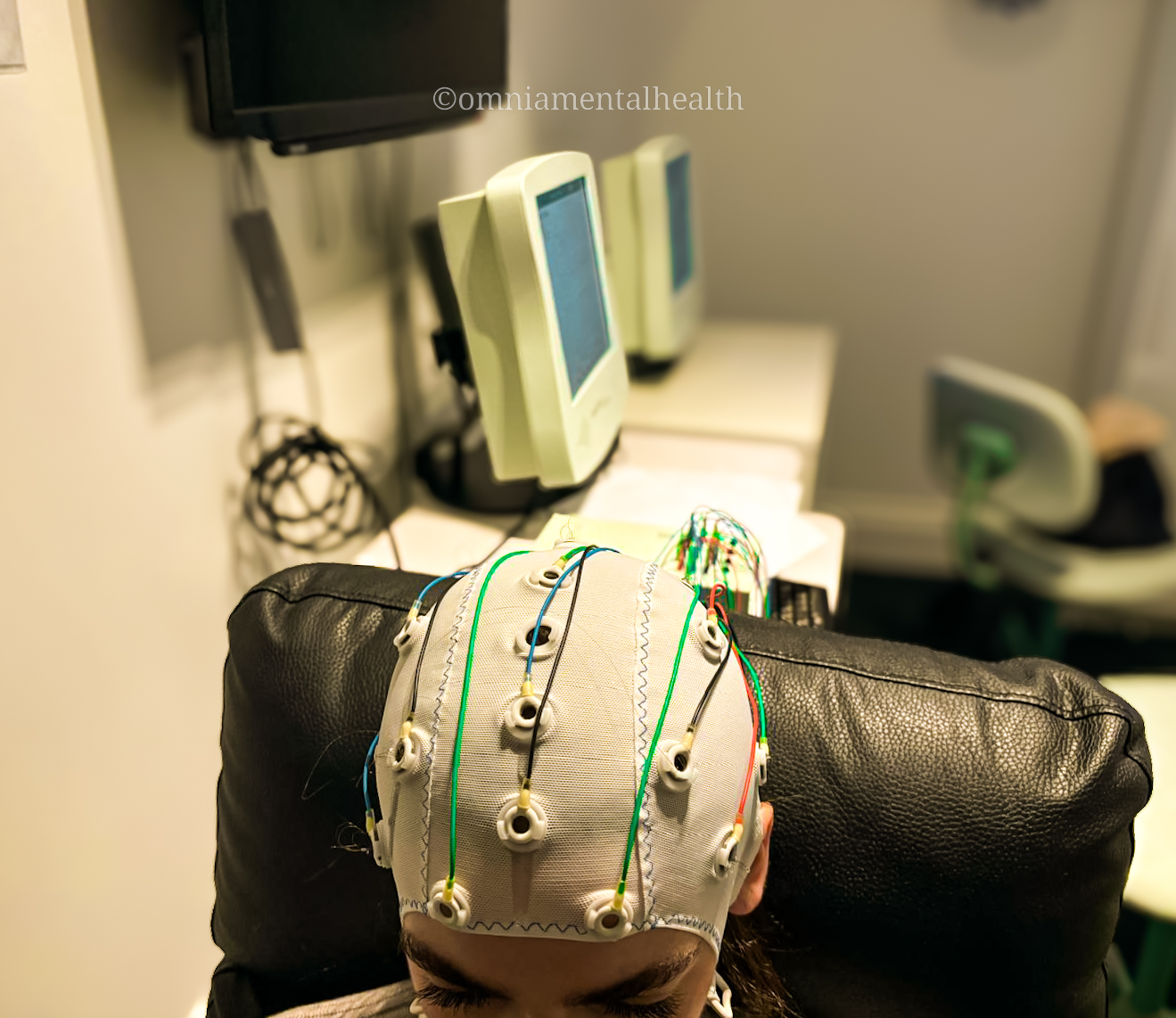
Quantitative Electroencephalography (qEEG)
Quantitative EEG (qEEG) is a non – invasive brain mapping tool that measures and analyses brainwave activity. It helps identify patterns of brain function that may underlie various psychological or neurological difficulties. qEEG can offer valuable insight into how the brain is functioning beneath the surface, even when symptoms are difficult to explain. By providing a detailed picture of how the brain is functioning, qEEG guides personalized treatment plans, including neurofeedback and other neuroscience – based interventions.
Here is an overview of its applications in mental health:
Diagnosis and Assessment
Depression: qEEG can help identify patterns of brain activity associated with depression, such as abnormal activity in the frontal lobes. It may reveal biomarkers that distinguish between different types of depression or predict responses to specific treatments.
Anxiety Disorders: Abnormal qEEG patterns, like increased beta activity, are often observed in anxiety disorders. These patterns can assist in diagnosing and differentiating between various anxiety disorders.
Attention Deficit Hyperactivity Disorder (ADHD): qEEG is commonly used to assess ADHD by identifying characteristic patterns, such as elevated theta/beta ratios. This can provide an objective measure to support clinical diagnosis.
Bipolar Disorder: qEEG may help differentiate between bipolar disorder and other mood disorders by identifying specific brain wave patterns during different mood states.
Treatment Planning
Personalized Medicine: qEEG can guide the selection of medications or other interventions by predicting how a patient might respond based on their brain activity patterns. For example, certain qEEG features might suggest a better response to SSRIs or other antidepressants.
Neurofeedback: qEEG is often used in neurofeedback therapy, where patients learn to regulate their brain wave patterns through real-time feedback. This is particularly effective in conditions like ADHD, anxiety, and PTSD.
Monitoring Treatment Progress
Medication Effects: qEEG can be used to monitor changes in brain activity in response to psychiatric medications, helping to adjust dosages or change treatments if the desired effects are not observed.
Therapy Outcomes: Changes in qEEG patterns can reflect the effectiveness of cognitive – behavioral therapy (CBT) or other psychotherapeutic approaches, allowing for adjustments in the treatment plan.
Relapse Prevention: By identifying early signs of relapse in conditions like depression or bipolar disorder, qEEG can inform proactive adjustments in treatment to prevent full – blown episodes.
Research and Understanding Pathophysiology
Biomarker Discovery: qEEG is a valuable tool in research to identify biomarkers for various psychiatric conditions, which can lead to better diagnostic tools and treatment methods.
Understanding Mechanisms: By studying brain wave patterns associated with mental health conditions, researchers can gain insights into the underlying neurobiological mechanisms.
Risk Assessment and Early Detection
Predictive Analytics: qEEG can help identify individuals at risk of developing mental health disorders, even before clinical symptoms appear. This is particularly relevant in high – risk populations, such as those with a family history of psychiatric disorders.
Non-invasive and Cost-effective
Accessibility: Compared to other neuroimaging techniques like fMRI or PET, qEEG is more accessible and less expensive, making it a practical tool in both clinical and research settings.
Limitations and Considerations
While qEEG is a powerful tool, it is not without limitations. The interpretation of qEEG data requires expertise, and the results should be integrated with other clinical assessments for accurate diagnosis and treatment planning. Additionally, there is ongoing research to further validate its applications and improve its accuracy in different psychiatric conditions.
qEEG is a valuable tool in mental health, offering objective insights that can enhance the diagnosis, treatment, and understanding of various psychiatric disorders. Its non – invasive nature and growing body of supporting research make it an increasingly important component of modern mental health care.
How qEEG Enhances Mental Health Care
qEEG has revolutionized the way mental health professionals approach diagnosis and treatment. Here’s how:
Precise Diagnosis and Assessment
qEEG helps in identifying unique brainwave patterns associated with specific mental health disorders, including:
Depression: Detects abnormal activity in the frontal lobes, offering insights into the type and severity of depression.
Anxiety Disorders: Reveals increased beta activity often linked to anxiety, aiding in accurate diagnosis.
ADHD: Assesses characteristic patterns, like elevated theta/beta ratios, supporting the diagnosis of ADHD with objective data.
Bipolar Disorder: Differentiates between bipolar disorder and other mood disorders through specific brainwave patterns.
Personalized Treatment Plans
By analyzing your brainwave data, qEEG helps tailor treatment plans to your unique needs:
Medication Guidance: Predicts how you might respond to certain medications, ensuring a more effective treatment plan.
Neurofeedback Therapy: Facilitates personalized neurofeedback sessions, where you learn to regulate brainwave patterns to alleviate symptoms of ADHD, anxiety, and more.
Monitoring and Optimizing Treatment Progress
qEEG isn’t just a diagnostic tool – it’s a companion throughout your mental health journey:
Tracking Medication Effects: Monitors changes in brain activity, helping to adjust medication as needed for optimal results.
Therapy Effectiveness: Evaluates the impact of cognitive – behavioral therapy (CBT) or other treatments by observing changes in brainwave patterns.
Relapse Prevention: Identifies early signs of relapse in conditions like depression or bipolar disorder, allowing for timely intervention.
Research and Innovation
qEEG is at the forefront of mental health research. By identifying biomarkers and understanding the neurobiological mechanisms underlying mental health conditions, qEEG is paving the way for new, more effective treatments.
Why Choose qEEG?
- Non – invasive and Safe: qEEG is a completely non – invasive procedure, making it safe for all ages.
- Cost – effective: Compared to other neuroimaging techniques, qEEG is more accessible and affordable.
- Scientific Accuracy: Backed by years of research, qEEG provides reliable data that can enhance the quality of your mental health care.
Take the First Step Towards Better Mental Health
If you or a loved one is struggling with mental health challenges, qEEG offers a path to understanding and healing. Contact us today to learn more about how qEEG can support your mental health journey.
Please complete the information below, and we will respond to you as soon as possible.
Opening hours
Monday - Sunday (9AM-9PM)